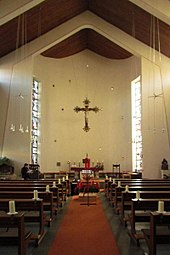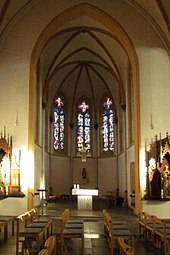St. Lambertus (Hückelhoven)
St. Lambertus is a Roman Catholic parish church in Hückelhoven in the Heinsberg district in North Rhine-Westphalia .
The church is dedicated to St. Lambert von Lüttich and entered under number 12 in the list of architectural monuments in Hückelhoven . It is the parish church of the parish of St. Lambertus and St. Barbara / Hückelhoven, founded on January 1, 2010.
location
The church building is located in the old town center of Hückelhoven on Dinstühlerstraße (L 364).
history
In the 13th century, Hückelhoven already had its own church. In 1261, Silbert von Hückelhoven received the right of patronage . In 1550 Hückelhoven was an independent parish . In the 16th century, Hückelhoven became Protestant at times, but then again Catholic.
Until the French times , the place belonged to the diocese of Liège and in 1802 it came to the newly founded diocese of Aachen . After this diocese was dissolved, the parish came to the Archdiocese of Cologne in 1825 . Since it was re-established in 1930, Hückelhoven has been part of the Aachen diocese again.
In 1933 the church of St. Barbara was built in the northern part of the parish, as Hückelhoven had grown rapidly due to mining. On January 21, 1960 the rectorate district of St. Barbara was completely separated from St. Lambertus and raised to an independent parish. On January 1, 2010, both the parish of St. Barbara and the parish of St. Lambertus were dissolved and merged to form the new parish of St. Lambertus and St. Barbara. St. Lambertus became the parish church of the new parish, St. Barbara Filialkirche . The St. Barbara Church was profaned in September 2016, since then there is only St. Lambertus as a Catholic church in the core town of Hückelhoven.
Building history
Nothing more is known about the church, mentioned in the 13th century. In the 17th century the church received a new nave and in 1691/92 a new sacristy . In 1773 a new bell tower was built, only the choir , which was older, remained. However, this choir was so dilapidated in 1883 that the triumphal arch was walled up and the choir could no longer be entered. As a result of this measure, the church became much too small for the community, so the parish decided to build a new church. The architects Heinrich Wiethase from Cologne , Jakob Frieling from Jülich and Peter Bartz from Heinsberg submitted designs, all three of which, however, were rejected by those responsible in the parish.
Ultimately, the decision was made in favor of the design by the Neuss government master builder Julius Busch . After the old parish church was demolished with the exception of the tower, the new church was built according to his plans between 1887 and 1888 and the bell tower from 1773 was increased by one storey. The solemn church consecration took place on July 10, 1889.
The damage caused by World War II was completely repaired by 1948. In 1954, a semicircular Lady Chapel was added to the north side of the bell tower. In the course of the 1950s the parish church became too small and it was decided to expand the church. The Cologne architect Wilhelm Hartmann was entrusted with the planning. Construction began in 1961 and the extension was completed in 1963. The result is a kind of double church. In doing so, four yokes of the south wall of the old parish church were broken open and the new church was added as a hall construction at a right angle. The consecration of the enlarged and rebuilt church finally took place on September 15, 1963.
Between 1991 and 1992 the old part of the church was converted into a weekday church, the plans for this were provided by Wolfgang Emondts.
Building description
The old part of the church is a neo-Gothic hall church in five bays made of bricks with a pre-built four-storey bell tower with an eight-sided hood in the west and a single-bay, five-sided closed choir in the east. The interior is spanned by ribbed vaults and the windows have two-lane tracery .
The new part of the church is built in a modern style and faces south. Breakthroughs in the four eastern yokes of the old church connect both parts of the church. The nave has four axes and tapers towards the south, where it then closes with a semicircular apse .
Furnishing
The altar in the new part of the parish church is made of Roman travertine and was made in 1962 according to a design by Wilhelm Hartmann. The bronze tabernacle adorned with rock crystals was also created by the sculptor Peter Haak from Erkelenz in 1962. Michael Franke created the ambo in 1984 from bronze. A neo-Gothic triumphal cross from the 19th century hangs above the altar , which was in the old part of the church until 1962. The oldest piece of equipment in the modern part is a Pietà from the 16th century. The organ from 1975 is the work of the organ building workshop Heinz Wilbrand from Übach-Palenberg and has 22 registers and an electric action . The stained glass windows are works by the artist Eduard Horst from 1961.
In the old part of the church there has been an altar and tabernacle by the artist Peter Haak since 1992, both of which were previously in the chapel of the former retirement home in Hückelhoven. The oldest piece of equipment is the font made of Namur bluestone , a work of the 12th or 13th century. This was already in the church mentioned in the 13th century. The two retables of the side altars from the 19th century and a confessional have been preserved from the neo-Gothic furnishings . Eduard Horst created the stained glass windows between 1952 and 1955.
Bells
In 1913 and 1924, the Otto bell foundry from Hemelingen / Bremen supplied a total of five bronze bells with a total weight of almost 3000 kg. From these previous chimes only the smallest bells remained.
| Surname | Chime | Caster | Casting year | |
|---|---|---|---|---|
| 1st bell | e¹ | Bochum association for cast steel manufacturing | 1960 | |
| 2nd bell | fis¹ | Bochum association for cast steel manufacturing | 1960 | |
| 3rd bell | g sharp¹ | Bochum association for cast steel manufacturing | 1960 | |
| 4th bell | h¹ | Otto company, Bremen-Hemelingen | 1914 | |
| 5th bell | cis² | Otto company, Bremen-Hemelingen | 1924 |
Particularities:
-Bell 1 was cast in the rather rare Durrippe
Motif: "Filled in Salve Regina"
Pastor
The following pastors have worked at St. Lambertus so far:
| from ... to | Surname |
|---|---|
| 1928-1938 | Gerhard Frenken |
| 1938-1944 | Fritz Dinstühler |
| 1945-1946 | Paul Wipperfürth |
| 1946-1947 | Heinrich Florence |
| 1947-1977 | Paul Schaaf |
| 1977-2003 | Dieter Wintz |
| 2003-2011 | Jürgen Frisch |
| 2011-2013 | Klaus Jansen |
| 2013-2014 | Gottfried Maria Graaff (parish administrator) |
| 2016-2018 | Georg Kaufmann |
Web links
Individual evidence
- ↑ Bischöfliches Generalvikariat (Ed.): Handbuch des Bistums Aachen 3rd edition, Aachen 1994, p. 772.
- ↑ Episcopal General Vicariate (ed.): Handbuch des Bistums Aachen 3rd edition, Aachen 1994, p. 773.
- ↑ Episcopal General Vicariate (ed.): Handbuch des Bistums Aachen 3rd edition, Aachen 1994, p. 773.
- ^ Hückelhoven, Catholic Church of St. Lambertus. In: Internet site Forschungsstelle Glasmalerei des 20. Jahrhundert eV Accessed on March 14, 2018 .
- ^ Gerhard Reinhold: Otto bells. Family and company history of the Otto bell foundry dynasty . Self-published, Esen 2019, ISBN 978-3-00-063109-2 , pp. 588, here in particular pp. 519, 525, 581 .
- ↑ Gerhard Reinhold: Church bells - Christian world cultural heritage, illustrated using the example of the bell founder Otto, Hemelingen / Bremen . Nijmwegen / NL 2019, p. 556, here in particular 483, 487, 544 , urn : nbn: nl: ui: 22-2066 / 204770 (dissertation at Radboud Universiteit Nijmegen).
- ↑ Bischöfliches Generalvikariat (Ed.): Handbuch des Bistums Aachen 3rd edition, Aachen 1994, p. 772.
Coordinates: 51 ° 3 '2.4 " N , 6 ° 13' 36.4" E




